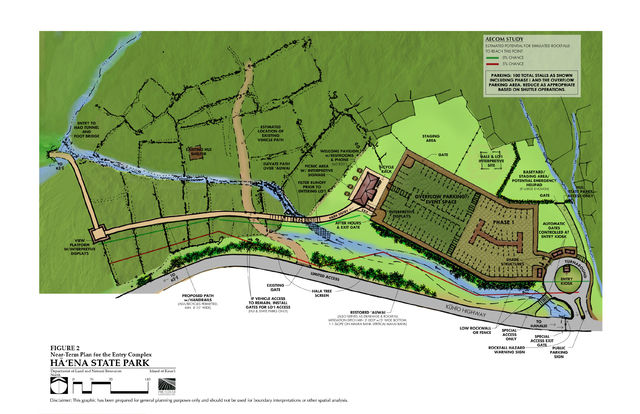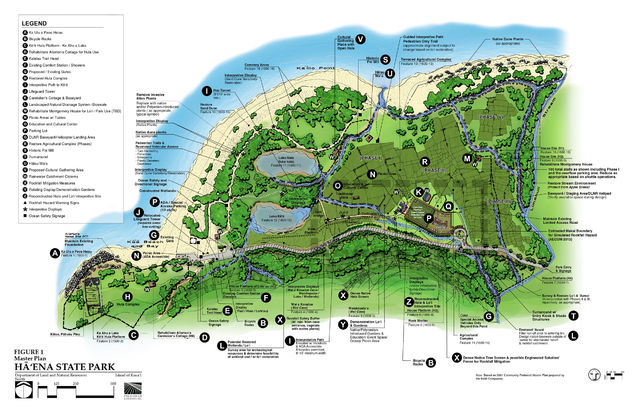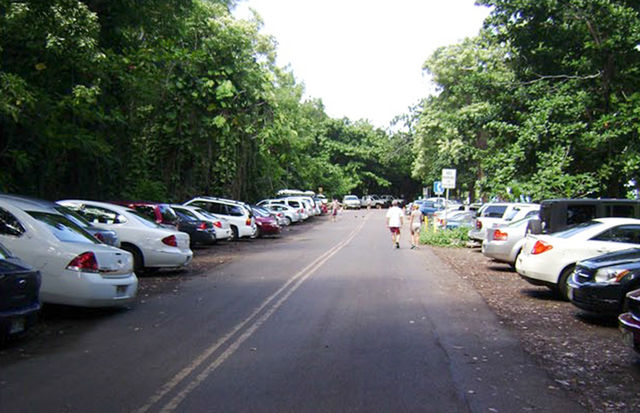HAENA — The Haena State Park of the future could include controlled entry, a 900-person daily visitor cap and beach access by way of an elevated boardwalk. That is the vision mapped out in an 800-page master plan geared at
HAENA — The Haena State Park of the future could include controlled entry, a 900-person daily visitor cap and beach access by way of an elevated boardwalk.
That is the vision mapped out in an 800-page master plan geared at renewing the park’s emphasis on Haena’s cultural and historical significance while resolving issues pertaining to large crowds, lack of parking and too much traffic.
“The place is screaming for some help,” said Kawika Winter, who is part of a 32-member committee formed to help develop a plan to mitigate problems at the congested visitor destination. “There’s too many people. It’s hard to enjoy it as the special cultural place that it is when it’s just overrun with people who have no idea how special it is.”
Haena State Park’s pristine shoreline, sheltered lagoon and scenic vistas make it one of the island’s most popular visitor destinations. With roughly 2,000 daily visitors, “the end of the road” is also one of the state’s busiest parks. Within its 66 acres, the park contains valuable cultural and ecological resources, as well as the Kalalau trailhead, gateway to the Napali Coast State Wilderness Park.
The master plan, assembled by the Department of Land and Natural Resources, is based on years of research and community input guided by a community advisory committee, a team of consultants, contractor PBR Hawaii and DLNR’s Division of State Parks. It also includes a draft Environmental Impact Statement.
DLNR is seeking public input on the proposal during a 45-day public comment period ending Sept. 8. The document is available for review at http://oeqc.doh.hawaii.gov/Shared%20Documents/Environmental_Notice/current_issue.pdf
Central to the plan is a proposal to limit the number of people who enter the park. A 900-person visitor cap would reduce the number of daily visitors by about half. The cap would affect hikers on the Kalalau Trail, but not overnight campers with valid permits.
The plan also proposes fees for park entry and/or parking, with Hawaii residents exempt.
“That’s probably the scariest thing and the biggest issue that the group wrestled with,” Winter said. “But a huge part of the problem is there’s so many tourists that local people don’t want to go down there. We want to reopen the area to the community.”
Lauren Tanaka, a planner for DLNR’s Division of State Parks, said reducing vehicle and foot traffic in the area will help protect the land while improving the visitor experience. As it is now, the high volume of cars and people in the park is a safety hazard.
Addressing that hazard means limiting parking to 100 cars, she said. Right now, there’s parking available to accommodate about 200.
Another component being considered is running a shuttle from Princeville to the park.
“It’s a means of organizing,” she said. “The status quo is not workable. It’s very congested down there. There’s a lot of safety issues. If you go down on a summer day, it’s really bad.”
An education center would become the park’s new point of entry. This is where visitors would be counted. The plan does not propose managing park entry from other points of entry, such as the Kalalau Trail or eastern shoreline.
Winter, who is the director of Limahuli Gardens, said the education center is key to encouraging public respect of the parks natural and spiritual resources.
“If we educate the tourists and teach them why this place is so sacred and so special, they will respect the cultural areas instead of running around like it’s a free for all,” Winter said.
“There’s a heiau, two wet caves that have their own names and stories, two fish ponds that are not currently in use, but the plan talks about restoring them, there are ancient taro patches and, of course, the most sacred element, the mountain Makana. The plan talks about restoring the native forest that once covered the mountain.”
The plan also recommends public safety improvements. A recent rockfall hazard study identified a high-risk area along the highway, which is the main visitor corridor to Kee Beach.
Under the proposal, access to Kee would be provided by an elevated boardwalk located makai of the highway, so as to take people out of a rockfall hazard zone where the road currently lies. The new pathway would offer visitors views of Makana, the famous mountain peak, as they make their way to the beach.




